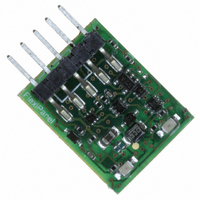TEACL-PIC-HV Flexipanel, TEACL-PIC-HV Datasheet - Page 2

TEACL-PIC-HV
Manufacturer Part Number
TEACL-PIC-HV
Description
PROGRAMMER TEACLIPPER/PIC HI/LOW
Manufacturer
Flexipanel
Series
TEAclipper™r
Type
ISP (In-System Reprogramming)r
Datasheet
1.TEACL-USB.pdf
(8 pages)
Specifications of TEACL-PIC-HV
Contents
Programmer Board
Positions/sockets
1
For Use With/related Products
PIC Micro® 10F and 18F MCUs
For Use With
658-1026-5 - ADAPTER USB TEACLIPPER658-1025-5 - BOARD EVAL TEACLIPPER658-1024-5 - ADAPTER DEBUG TEACLIPPER/STAMP658-1023-5 - ADAPTER DEBUG TEACLIPPER/PICICD2
Lead Free Status / RoHS Status
Lead free / RoHS Compliant
Other names
658-1019-5
Loading Firmware onto the TEAclipper
To load a TEAclipper with a firmware data payload, start
the HexWax Explorer application (downloaded from
www.hexwax.com). Import the .hex or .wax file
containing the firmware you want into the Local Files
section of HexWax Explorer. To import local files held
on your computer, press the Add… button. To import
files from HexWax, navigate to the firmware you want
and press the Click To Download button in the browser
area.
Insert the TEAclipper into the TEAclipper USB adapter.
The LEDs should be face upwards, although you will not
damage the TEAclipper if you insert it incorrectly.
Select the .hex or .wax file you wish to load and press
the Charge Now… button. The Charge TEAclipper PIC
dialog will appear:
You will be given the following options:
Target PIC: Specifies the type of PIC for which the hex
data is intended.
in .hex files and so must be specified here. It is not
always possible to cross-check that the PIC type is
correct, so be careful to set it correctly.
Either high-voltage or low-voltage programming may be
specified, depending on the target device. Some PICs
require high-voltage (7V-13V) programming; others
require low-voltage programming; some may be
programmed
programming is only possible using TEAclippers
incorporating high-voltage generator components.
If low-voltage programming is specified, there may be a
supply voltage minimum below which bulk erase
operations cannot be performed. Programming is only
possible below this limit with high voltage erase.
LF series devices identical to F series are identical to F
series devices, e.g. PIC18LF4520 is the same as
PIC18F4520, except that LF series devices may be
operated at lower voltage. To specify an LF device,
simply specify its F series equivalent.
Serialization:
certain memory locations to unique values.
The memory locations may not cross a page write-byte
boundary and must be word aligned. Dummy values
must be declared in the source code for these locations.
Page 2
13-Jan-08
by
Serialization options allow you to set
This information is not contained
either
method.
TEAclipper//PIC DS508-6
High-voltage
© FlexiPanel Ltd
When the TEAclipper attempts to write the dummy
values, it will substitute the serialization values.
The values can be stored directly or as literals in
RETLW instruction (i.e. in the same manner as the
Microchip PM3 SQTP facility programmer).
Fixed: A fixed value of up to 4 bytes (Stamps) or 16
bytes (PICs) to each target during programming. This
option requires limited discharge to be enabled.
Random: A random value of up to 16 bytes to each
target during programming. This option requires limited
discharge to be enabled.
Increment:
(Stamps) or 16 bytes (PICs) to each target during
programming. This option requires limited discharge to
be enabled. The value is written little-endian, i.e. least
significant byte first. Note that PIC increments do not
carry beyond the fourth byte.
Limited Discharge: Allows you to limit the number of
discharges of the payload for licensing purposes. Note
that each 16 discharges will require an erase cycle.
Payload name: This name will appear in the Explorer
view Payload information area when the TEAclipper is
inserted into the TEAclipper USB adapter.
Version number: If non-zero, this version number will
appear in the Explorer view Payload information area
when the TEAclipper is inserted into the TEAclipper
USB adapter. The value is a two-byte hex number.
URL: The URL which will be navigated to when the
TEAclipper is inserted into the TEAclipper USB adapter
and the Lookup button is pressed.
After Programming: Specify whether the TEAclipper
should hold the target in a reset state until it is removed,
or whether to tri-state immediately and allow the target
to execute.
Security Options:
serialization information can be read out of the
TEAclipper.
Checksums: The checksums are a shorthand method
of verifying that you have the correct payload and dialog
settings. (They are not the same checksums as used
by MPLAB.)
Preserve / Authenticate:
leaving certain areas of ROM or EEPROM unchanged
during programming (preserve), or of only programming
if the ROM or EEPROM locations match the values
specified in the hex file (authenticate). The first of these
options is useful if you wish to leave serial numbers,
MAC addresses, calibration data unchanged.
second is useful when upgrading to ensure that the right
target device is being upgraded.
Note for 10F, 12F and 16F devices, two bytes are used
for each 12-bit or 14-bit ROM location and each 8-bit
EEPROM location. Addresses are specified in bytes, so
address values and lengths may be double what you
would expect.
Dummy values must be declared in the source code for
the preserve / authenticate memory locations.
An incrementing value of up to 4 bytes
Patents pending
Specify whether or not the
You have the options of
www.FlexiPanel.com
The






















